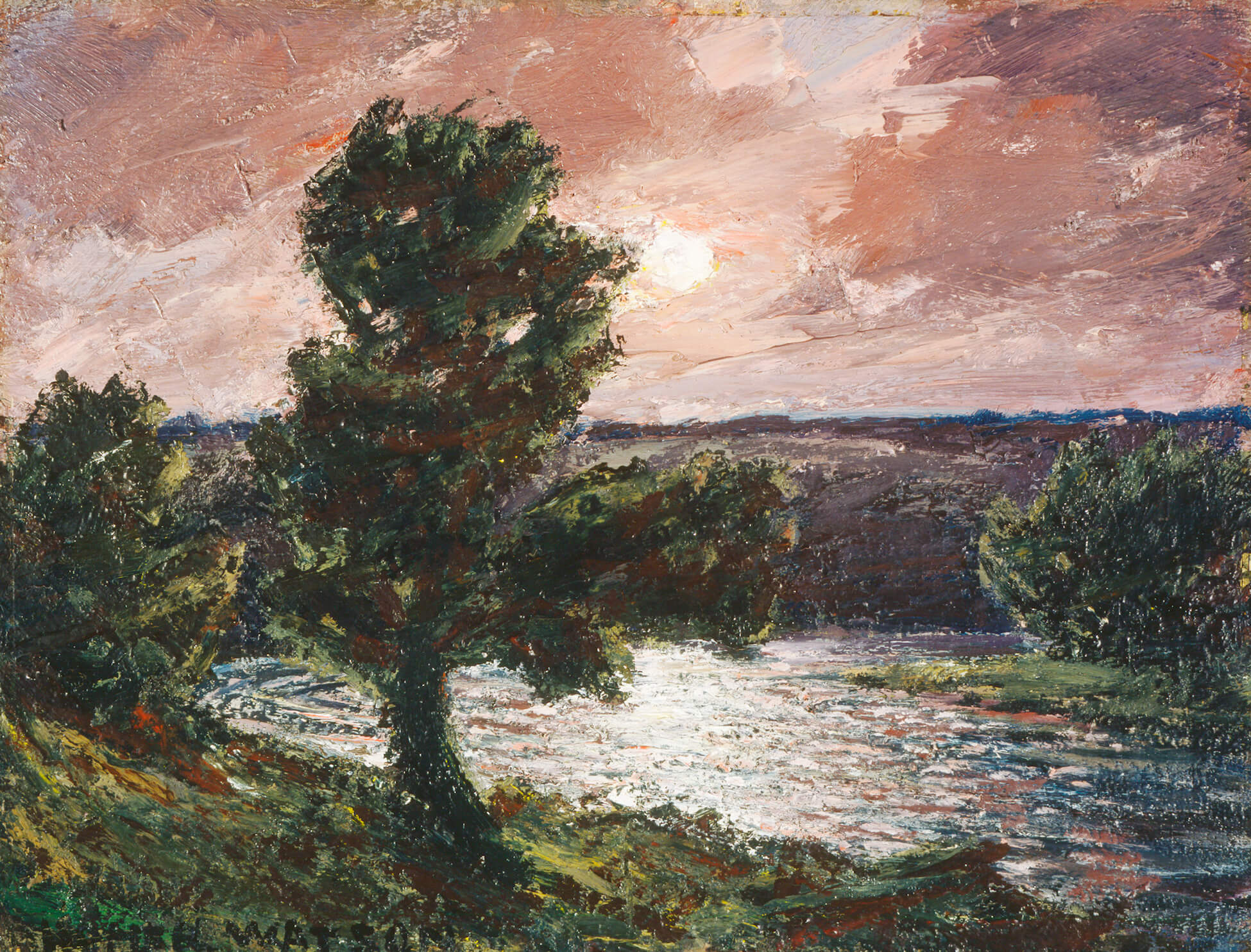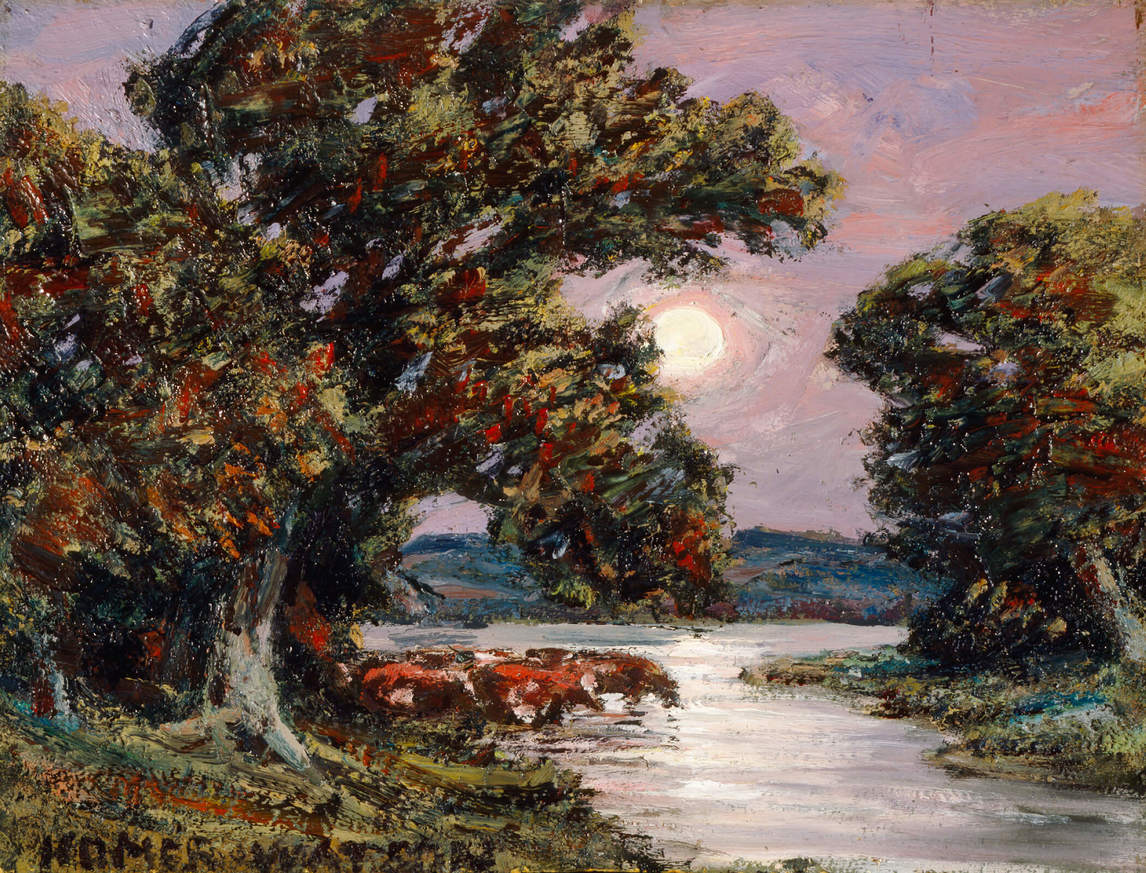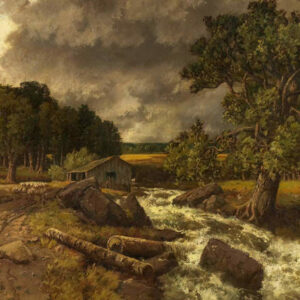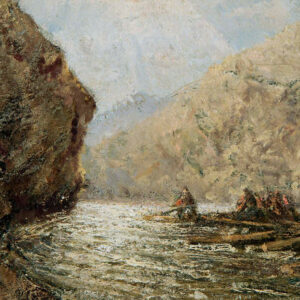Moonlit Stream 1933

Homer Watson, Moonlit Stream, 1933
Oil on canvas, 31.8 x 41.9 cm
Library and Archives Canada, on loan to Laurier House, Ottawa
In 1933 William Lyon Mackenzie King, the three-time prime minister of Canada between 1921 and 1948, acquired two paintings from Watson: Evening Moonrise and Moonlit Stream, both 1933. The latter, a dark, heavily painted night view of a river reflecting the unnatural colours of clouds in a moonlit sky, was a purchase. At the same time, Watson gave King Evening Moonrise as a gift. Both canvases seem to have been entirely studio projects, rather than beginning life on one of the painting trips that had led to, for example, Moonlight, Waning Winter in 1924.
King had been born and had grown up near Doon, in Berlin (now Kitchener), Ontario, and as an adult had become friends with Watson. Their rapport was strengthened by their shared interest in the Kitchener-Waterloo region, as well as in spiritualism and the occult. Watson was intrigued by spiritualism throughout his life and, although his writings on the subject are vague, he seems to have adhered to a pantheistic approach that sought out transcendent meaning in natural phenomena. “All nature up to the horizon uttered the sombre chord that would be in unison with the refrain of the lost and the caverns of the forest vibrated in their mystic depth,” he reminisced in an undated description of experiencing a landscape at night. “[Everything] seemed connected together by invisible ties and the limits of earth seemed to mount in the air and be linked with the spirits of other worlds.”

Moonlit Stream may be interpreted as supporting these ideas by means of its evocative darkness, the unnatural colours in the sky and water, the blurring of worldly detail, and the prominent inclusion of a moon that lights up the surrounding darkness. For his part, King’s understanding of the painting steered closer to religion than to the pantheistic interpretation preferred by Watson. In one letter King described Moonlit Stream as being “[a]bove all … a sort of presence, reminding me always of the life beyond the veil, and of art finding its perfection there,” while in another he waxed poetic about the painting’s light being “like the answer to the prayer ‘Lighten our darkness we beseech thee, O Lord.’ It has caught the Divine light.” However, King also confessed that he had difficulty understanding the unusual colours in the skies of both Moonlit Stream and Evening Moonrise. Certainly, the tonalities in Moonlit Stream’s sky have little in common with those used by other Canadian artists, whether traditional or modern.
Its small size was due principally to the several health crises that had hampered the seventy-eight-year-old Watson’s ability to work on a larger scale. And although the thickness with which it was painted, the corresponding loss of naturalistic detail, the darkness of the landscape, and the startling colours in the sky and river were not innovations at this point in Watson’s career, they are brought together here with a new degree of intensity. Moonlit Stream thus exists as a highly personal end-of-career statement by an artist who had been disconnected for some fifteen years from developments elsewhere in Canadian art. Indeed, 1933, the year in which Watson created Moonlit Stream, was also the year that saw the birth of the Canadian Group of Painters: a group in which most of the twenty-eight founding members were exponents of various strands of Canadian modernist art. Moonlit Stream bears no similarity to the work of any of them.

 About the Author
About the Author
 More Online Art Books
More Online Art Books
 Acknowledgements
Acknowledgements